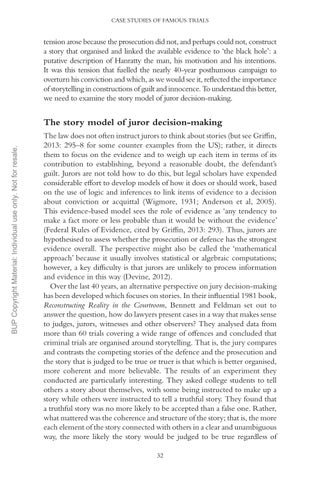CASE STUDIES OF FAMOUS TRIALS
tension arose because the prosecution did not, and perhaps could not, construct a story that organised and linked the available evidence to ‘the black hole’: a putative description of Hanratty the man, his motivation and his intentions. It was this tension that fuelled the nearly 40-year posthumous campaign to overturn his conviction and which, as we would see it, reflected the importance of storytelling in constructions of guilt and innocence. To understand this better, we need to examine the story model of juror decision-making.
BUP Copyright Material: Individual use only. Not for resale.
The story model of juror decision-making The law does not often instruct jurors to think about stories (but see Griffin, 2013: 295–8 for some counter examples from the US); rather, it directs them to focus on the evidence and to weigh up each item in terms of its contribution to establishing, beyond a reasonable doubt, the defendant’s guilt. Jurors are not told how to do this, but legal scholars have expended considerable effort to develop models of how it does or should work, based on the use of logic and inferences to link items of evidence to a decision about conviction or acquittal (Wigmore, 1931; Anderson et al, 2005). This evidence-based model sees the role of evidence as ‘any tendency to make a fact more or less probable than it would be without the evidence’ (Federal Rules of Evidence, cited by Griffin, 2013: 293). Thus, jurors are hypothesised to assess whether the prosecution or defence has the strongest evidence overall. The perspective might also be called the ‘mathematical approach’ because it usually involves statistical or algebraic computations; however, a key difficulty is that jurors are unlikely to process information and evidence in this way (Devine, 2012). Over the last 40 years, an alternative perspective on jury decision-making has been developed which focuses on stories. In their influential 1981 book, Reconstructing Reality in the Courtroom, Bennett and Feldman set out to answer the question, how do lawyers present cases in a way that makes sense to judges, jurors, witnesses and other observers? They analysed data from more than 60 trials covering a wide range of offences and concluded that criminal trials are organised around storytelling. That is, the jury compares and contrasts the competing stories of the defence and the prosecution and the story that is judged to be true or truer is that which is better organised, more coherent and more believable. The results of an experiment they conducted are particularly interesting. They asked college students to tell others a story about themselves, with some being instructed to make up a story while others were instructed to tell a truthful story. They found that a truthful story was no more likely to be accepted than a false one. Rather, what mattered was the coherence and structure of the story; that is, the more each element of the story connected with others in a clear and unambiguous way, the more likely the story would be judged to be true regardless of 32

